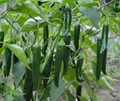
Ghost pepper also known as Bhut jolokia is a small chili of red or orange color with a smooth skin. The peppers are about 2.5 to 3.5 inches long and 1 inch thick - just the size of your thumb. Originally, ghost pepper hails from India, where it is grown in states like Arunachal Pradesh, Assam, Nagaland and Manipur.
The spiciness of chili peppers' is rated in Scoville heat units (SHUs). To understand better, a bell pepper rates a ‘zero’, Tabasco sauce is 2500 to 5000 SHUs and a jalapeño is 3500 to 10000 SHUs. Till 1980 it was broadly accepted that the hottest peppers topped out at about half a million and then came the ghost pepper at 1,000,000+ SHUs. The fruit from a ghost chili pepper variety known as Trinidad Moruga Scorpion has been recognized as the world’s hottest pepper in the Guinness Book of World Records.
Uses of ghost peppers
In India, the ghost peppers are generally used as a medicine for stomach problems and consumed to calm the body by inducing perspiration especially in the summer season.
Recently, one more use has been discovered for growing this hot chilli peppers. Scientists in 2009 suggested that the ghost peppers can be used as weapon - either in hand grenades or as a pepper spray. This will cause a temporary paralysis but no permanent damage to the terrorists or attackers. In fact we can say that ghost pepper plants are quite possibly the next environmentally friendly, non-lethal weapon.

Method of growing ghost peppers
Now the most important question is how to grow the ghost peppers?” So let us tell you very clearly that growing ghost peppers is difficult as compared to other chili peppers because of their requirements for a certain amount of moisture as well as heat, which is in direct relation to their high-temperature index.
If you want to best grow these hot peppers then there have to be 5 months of intensely high humidity and temperatures like in India.
If the growing period is short, you can move the ghost pepper plants indoors in the sunset; though, these plants are sensitive to changes in their environments and lots of moving around might harm the plants irreparably. Hence the best place to grow ghost peppers is indoors or in a greenhouse, where the temperatures can be maintained at 75 Fahrenheit or 24 degree Celsius.
Remember that the seeds for ghost peppers usually take around 35 days to germinate in a very warm soil in between 27 to 32 degree Celsius, while keeping the soil damp consistently. You can also dip the seeds in hydrogen peroxide for a minute or two to increase the germination process and also utilize full sun fluorescent light bulbs to maintain temperature and humidity.
Caring of ghost peppers
As your ghost peppers are very sensitive to over fertilization, changes in temperature and other environmental stresses, make sure the plants must have a growing season of longer than 3 months in 21 degree Celsius temperature (in order to be grown outdoors).
If you are growing ghost peppers in pots or containers, always use a well-draining potting medium. Growing peppers in the backyard may need to have organic manure added to the soil, especially if the soil in filthy.
Then fertilize the newly planted ghost pepper plants at least 2 to 3 times during the growing season. You can also use a controlled release fertilizer to nourish the plants during the whole growing period. And lastly, maintain a light watering rule to avoid shocking the fragile peppers.
Pollination
Precise and proper pollination will definitely help you grow ghost peppers fruitfully. For this, bring in bees by cultivating many flowers in your home garden. Make sure the ghost peppers are cultivated in a place with good air circulation.
Harvesting
While harvesting the ghost peppers, it is always advisable to wear gloves to prevent any burns or inflammation from the peppers. You should harvest them when the fruit is strong enough and brilliantly colored in red or orange.
To conclude, growing ghost peppers or Bhut jolokia in your kitchen garden will give you enough home grown heat for the whole season and even more.











